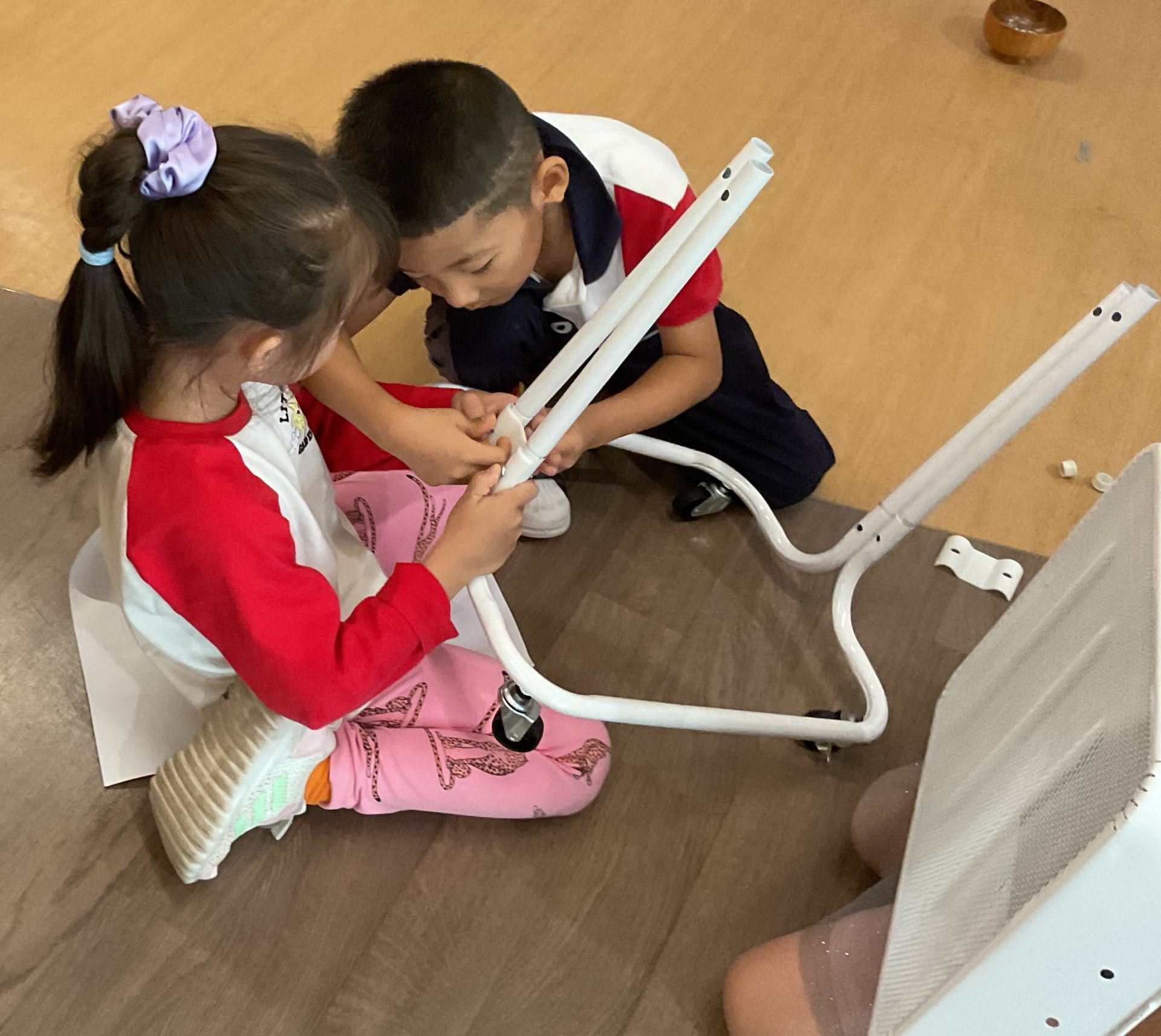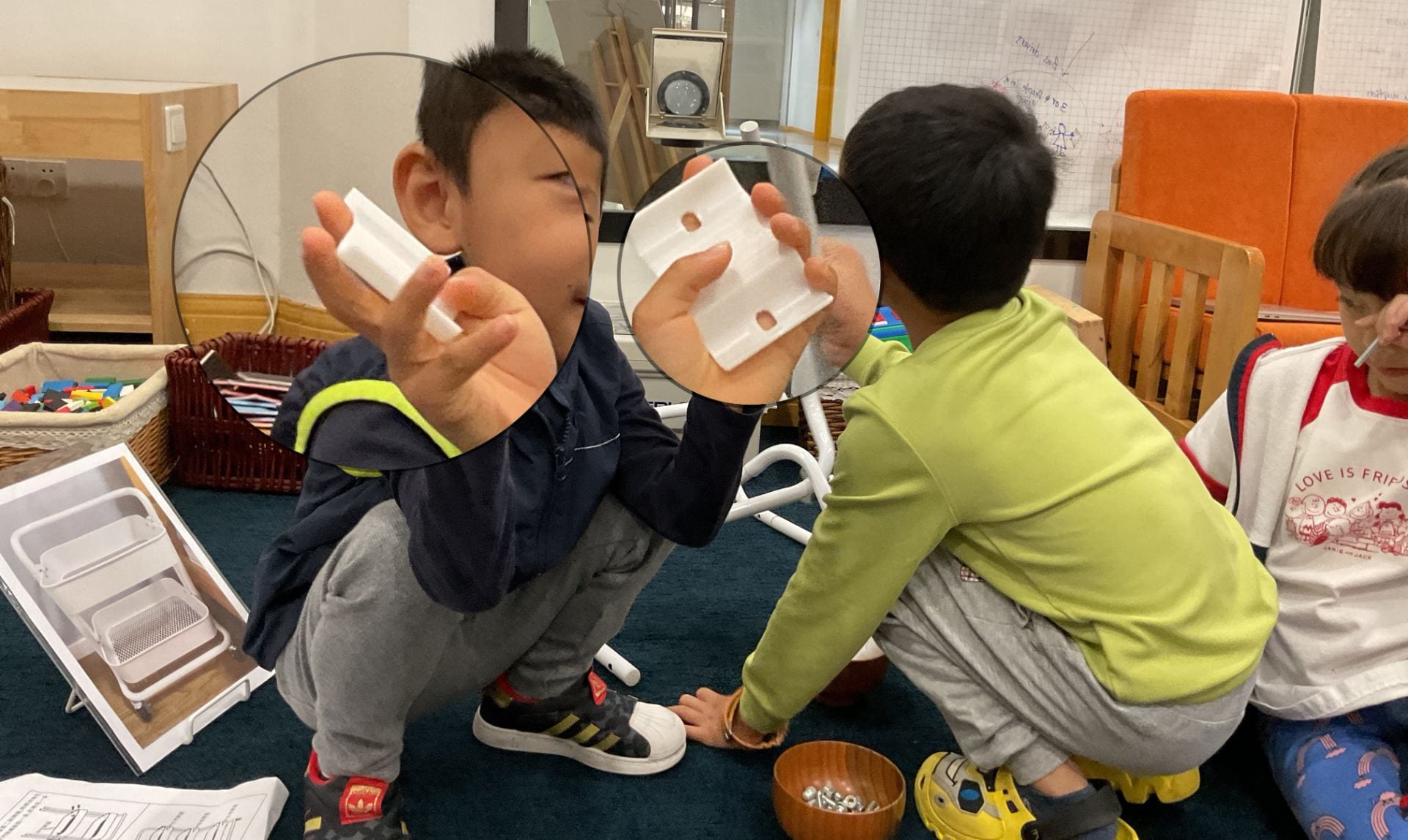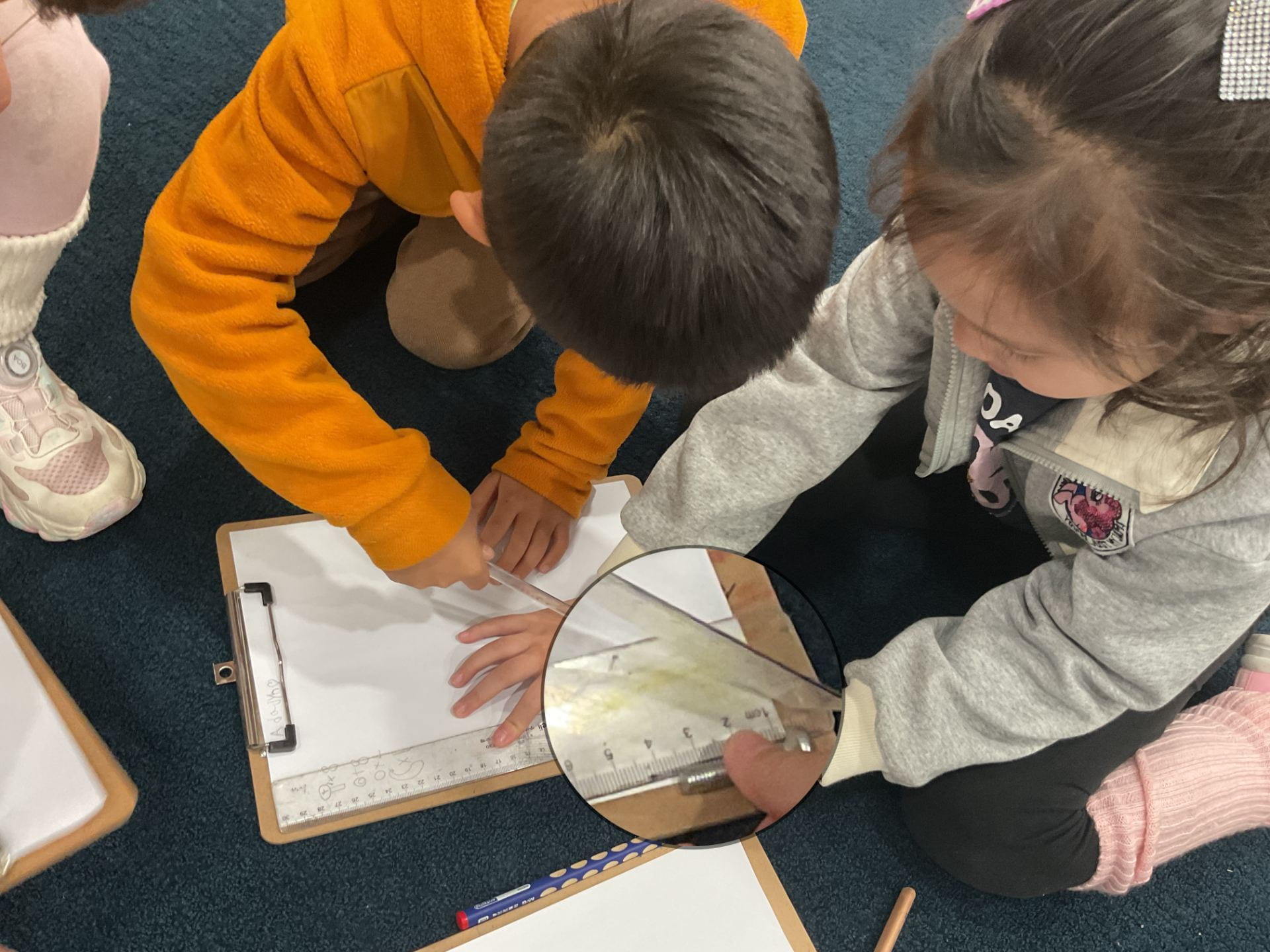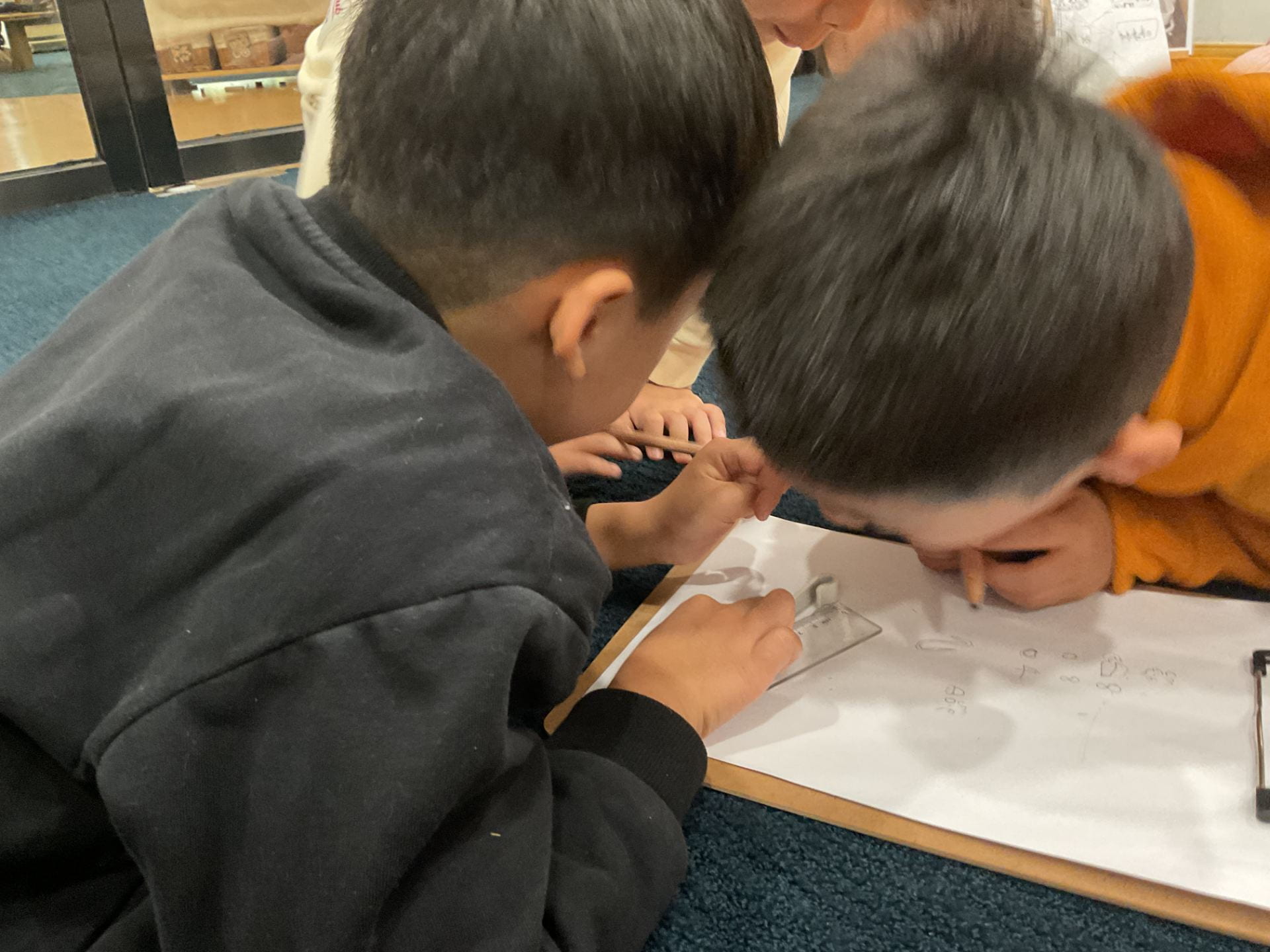The Trolley Project
The Provocation
At the beginning of the year, a trolley for the water bottles was ordered for the class. We were excited to see the box with all the components needed for the trolley. But who will assemble the trolley?
The teachers decided to Present the idea to the children as a provocation. 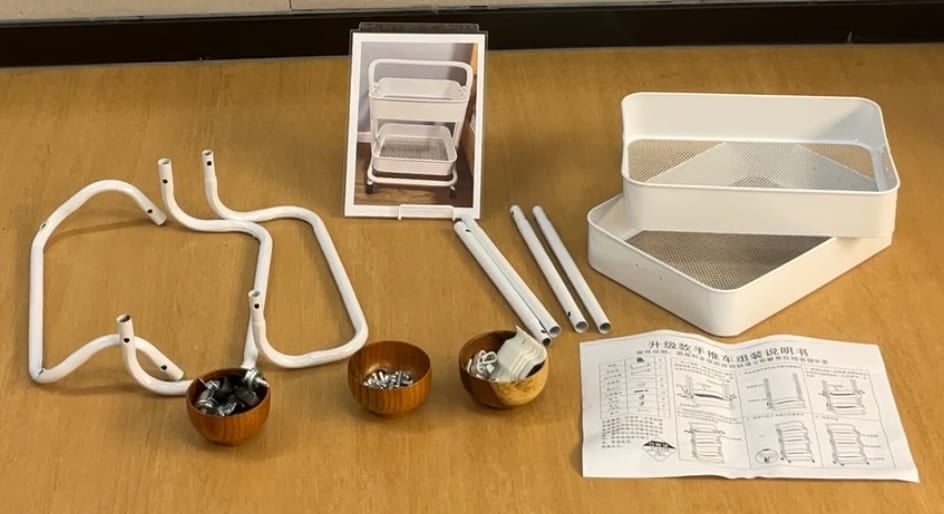
The next morning, some of the children noticed the provocation and discussed the idea.
They wondered what the different parts were and how they might be used.
- Isabella “I know, they are parts of a trolley. We used to assemble a trolley when I was in Ms. Pat’s class last year.”
- Suzy “Maybe we can help assemble this one.”
They began to take a closer look at the pieces. Noticing this interest, other children gathered to see what was happening.
- Jacob “我来负责看说明书。” I can be in charge of reading the instructions.”
- Evan “早知道我带个电钻来了。” I should have brought an electric screwdriver if I knew it before.”
- Finn “看,这是这个!”(he pointed at the something on the instruction, ‘look, it is this’)
- Evan “乔治,你装反拉,这个需要把它转过来。”(“George, you did it the opposite way. You should turn it around to the other side.”)
 Isabella “Evan and George, do you still remember we assembled one trolley like this last year?”
Isabella “Evan and George, do you still remember we assembled one trolley like this last year?”
 Isabella “以前Ms.Pat 是不是像这样把推车给推走的?” (Did Ms. Pat hold it like this to push the trolley before, Evan?) Ms. Karen 以前带你们做过这个吗?(Did Ms. Karen do this with you in K1A, Adalyn?)
Isabella “以前Ms.Pat 是不是像这样把推车给推走的?” (Did Ms. Pat hold it like this to push the trolley before, Evan?) Ms. Karen 以前带你们做过这个吗?(Did Ms. Karen do this with you in K1A, Adalyn?)
 Evan tapped into his prior knowledge and tried to assemble the trolley.
Evan tapped into his prior knowledge and tried to assemble the trolley.
 George realised the significance of the picture of the assembled trolley and pushed it closer to the group. The assemblers began their work.
George realised the significance of the picture of the assembled trolley and pushed it closer to the group. The assemblers began their work.
 They continued to work on the trolley for a while, and then Evan realised that they needed to revisit the instructions. “这是说明书,你能看懂字吗Jacob?” (this is the instruction, can you read the Chinese characters, Jacob?)
They continued to work on the trolley for a while, and then Evan realised that they needed to revisit the instructions. “这是说明书,你能看懂字吗Jacob?” (this is the instruction, can you read the Chinese characters, Jacob?)
Through trial and error, they continued to explore the complicated instructions, trying to figure out which parts went together. Some children slipped away to explore other spaces, but Jacob, Evan, Isabella and Adalyn continued to stay interested in assembling the trolley. They continued to persevere, finally deciding that it was important to develop a plan of action.
 Jacob “Since the trolley has two parts, we can have two groups working on assembling it. Isabella and I will be in a group, and we are going to be in charge of the bottom layer. Evan and Adalyn, you two can be a team and work on the top layer.”
Jacob “Since the trolley has two parts, we can have two groups working on assembling it. Isabella and I will be in a group, and we are going to be in charge of the bottom layer. Evan and Adalyn, you two can be a team and work on the top layer.”
The group assembling the lower shelf began their work. They decided that when they were finished, the top group would take over. As they were working, they referred to the picture and the instructions when needed.
As we observed the children at work, we noticed how they used their communication skills to express their thoughts and ideas with each other to solve a common problem. They understood the significance of the instructions and their connection to the different components of the trolley. They used what they knew about pictures, Chinese characters, numbers and words to read the instructions and explain their understanding to each other.
Their idea of ‘making a plan’ to help with the process of assembling the trolley, and their decision-making demonstrates their understanding of the process, and teamwork and show their developing understanding that people work together for different purposes.
Parts and Instructions
Over the last few days, the team of assemblers have continued to work on the trolley. They felt it was very challenging to put the parts together. They gathered to discuss the problem before they began their task.
They began by looking carefully at all the different parts of the trolley.
- Isabella “We have the small parts such as screws and wheels.”
- Adalyn “We have the nuts.”
- Jacob “We have the holders for holding the sticks.”
- Isabella “We have the tools for assembling the trolley.”
- Evan “We have the words.”
- Adalyn “那个叫说明书。”(that’s called the instruction) A picture of the trolley.”
- Jacob “The big parts of the trolley, like the baskets and sticks to connect them.”
Now that we have all the different parts of the trolley and the tools to assemble it, where do we start? Adalyn suggested that they read the instructions carefully. Isabella emphasised the importance of the pictures in the instructions. However, as they tried to assemble it, Evan could see that it was very wobbly. Isabella suggested taking the wheels off. Jacob agreed, explaining that this could come right at the end.
Adalyn suggested that they read the instructions carefully. Isabella emphasised the importance of the pictures in the instructions. However, as they tried to assemble it, Evan could see that it was very wobbly. Isabella suggested taking the wheels off. Jacob agreed, explaining that this could come right at the end.
- Isabella “There are some numbers that show us the steps.”
- Jacob “Some parts such as the long sticks are too hard for us to insert”
- Evan “We don’t have enough muscle.”
- Jacob “We need an adult to help.”
- Isabella disagreed and said, “We children can work together”.
The team continued their work together, assembling and dismantling parts of the trolley as they tried to complete the task. During the week, a clean-up in the Early Years centre posed a new problem!
One morning, when the team went back to continue with their project, they found some of the parts were missing. How can we assemble the trolly without the parts?
Yet again, the team sat down together to work out which parts were missing. And how they might solve the problem. Isabella suggested that they look at the paper instructions to figure it out.
 The instructions provided information on all the different parts that were required to assemble the trolley. They needed screws, nuts, black rings on the wheels, hooks and the holders. Together the team tried to calculate how many of each they needed in total. The problem invited the children to use their understanding of calculations to find the number of missing parts.
The instructions provided information on all the different parts that were required to assemble the trolley. They needed screws, nuts, black rings on the wheels, hooks and the holders. Together the team tried to calculate how many of each they needed in total. The problem invited the children to use their understanding of calculations to find the number of missing parts.
- The nuts: Adalyn “We need 12 in total and we used 4, so 8 of them are missing.”
- Hooks: Jacob “We had two before and now we only have one.”
- The holders for the screws: Evan “There are 6 in total on the instructions, but there are three levels in the instructions, and we only need 2 levels for our trolley so we need two more.”
 They continued to work on creating a list of items they needed. Then, the team plan their next steps to solve the problem.
They continued to work on creating a list of items they needed. Then, the team plan their next steps to solve the problem.
Jacob suggested asking the facilities department for the missing parts because they have the staff who come and fix items that are broken in the classroom. Isabella suggested reaching out to Mr. Matt as he helped fix the table. Jacob recalled Mr. Arek helping to fix ‘The Nest’ in the playground. Adalyn thought Ms. Jo might be able to help as well as she has lots of different materials for making things.
- Adalyn “If none of the people that we mentioned above has the parts we need, we can buy another set of the small losing parts we need.”
- Jacob disagreed, “if we buy only a set of the small parts, the other trolley is going to miss some parts.”
- Evan disagreed with Jacob, “I think the shop must have some extra small parts.”
 Everyone agreed with Evan’s suggestion, and they decided to ask the school purchasing office to help them source the missing parts. To do this they decided they had to:
Everyone agreed with Evan’s suggestion, and they decided to ask the school purchasing office to help them source the missing parts. To do this they decided they had to:
- take a photo of the parts they need
- make a list of the parts that need to be purchased
- measure the size of the different parts to give accurate information.
They worked together to gather all this information to take to the school’s purchasing officer. We look forward to their next steps as they solve the problem of ordering and purchasing the missing pieces in the trolley.
Measuring Accurately
The team reviewed the information they had gathered about the missing components to decide their next steps. Isabella volunteered to help with the process.
 They decided that an important first step was to measure the missing parts accurately, to order the correct items. The team used what they knew about measurements and measuring tools to begin their work.
They decided that an important first step was to measure the missing parts accurately, to order the correct items. The team used what they knew about measurements and measuring tools to begin their work.
- Jacob “You should measure it from the top.”
- Adalyn “But I think it is better to only measure the stick part.” (She thought she should start with 1cm.)
- Jacob “The length of the screw is a bit longer than 3 and a half.”
 The team sought Ms. Sophia to discuss the function of the hash marks on the ruler, exploring the connection between millimetres and centimetres. They found that each small space was 0.1cm, and the measurement was 3.6 centimetres.
The team sought Ms. Sophia to discuss the function of the hash marks on the ruler, exploring the connection between millimetres and centimetres. They found that each small space was 0.1cm, and the measurement was 3.6 centimetres.
Evan placed marks on the picture and drew an arrow to the number, to show the purchasing officers which part of the screw they were measuring.
He wrote the unit cms beside it, which lets others know what the number means. Everyone decided to follow Evan’s method to avoid any confusion.
Jacob decided that he wanted to measure the diameter of the nut and placed the ruler on the head of the nut to find the measurement.
Evan and Jacob measured the length of the hook, it was 4.5 cms.
Adalyn thought it was necessary to also measure the width of the hook, “It is 0.9 cm wide!”
- Jacob “We don’t have the black rings to use as a example because they are all missing. But I can draw a picture of them instead.”
- Adalyn “But it is not the exact thing. It’s just your picture of the thing, and there must be some differences between your drawing and the thing we want. We can take a photo of the wheels to show people, because the rings are for the wheels.”
- Isabella “And we should measure the wheels as well.”
- Adalyn “It is 7 cm.”
- Jacob “No, it is 8 cm.”
- Adalyn “If you measure it from 0, it is 7 cm, and if you measure it from 1, it is 8 cm.”
After we took a break from the project, Adalyn and Isabella decided to work together to find out how many millimetres there are in 1 cm using a ruler to count all the small lines between the 2 numbers.
- Isabella “It is too hard for me to count the small lines because they are too small.”
- Adalyn “We need a magnify glass to help us look more clearly.”
They worked as a team to figure out that there are 9 lines between 2 numbers on the ruler, and if they add the two long lines right under the two numbers, there are 11 lines.
Isabella “So how many millimetres are there in 1 cm? 9 or 11?


